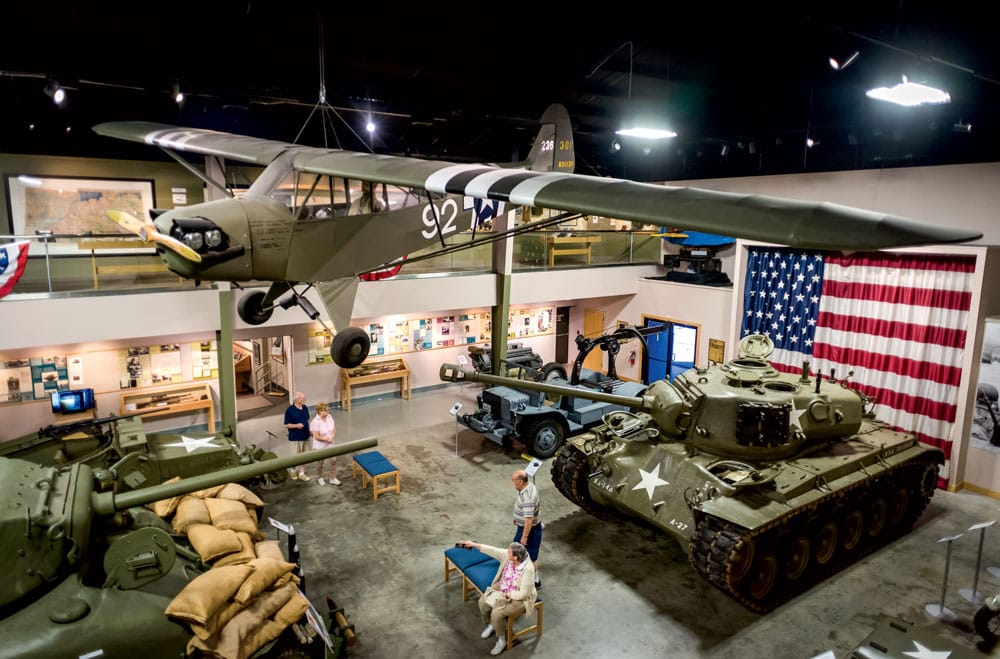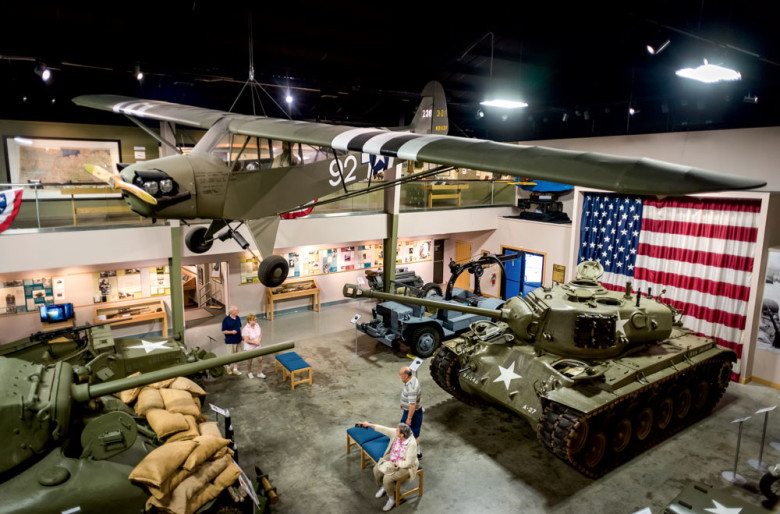Wright Museum of World War II | Local Treasure
On the 75th anniversary of Pearl Harbor, the Wright Museum connects generations of veterans and their families.

The vehicle gallery holds center stage, but it is the context provided by the memorabilia and period exhibits that truly sets the Wright Museum apart.
Photo Credit : Michael Seamans
Photo Credit : Michael Seamans
As I sat in the small theater at the Wright Museum of World War II watching a film loop about the build-up to America’s involvement in the war, a man who had also been watching came over and introduced himself.
His name was Dan Schroeder, and he said he’s been volunteering at the museum since 2009. His son, Chris, the fourth generation of his family to serve, was just back from Afghanistan. “This place is important,” Dan said. “I’ve met soldiers and families from all over the world here. We learn and we share and we remember. It connects us.”
Located in the scenic lake town of Wolfeboro, New Hampshire, the Wright Museum makes a memorable first impression. The building’s roadside façade turns heads, with its genuine M3A1 Stuart tank seemingly busting out through the wall. A book shouldn’t be judged by its cover, however. This is more than just a military museum.
Each year, the more than 16,000 visitors who tour the Wright Museum get up close and personal with a collection of fully operational military vehicles, sure, but they also explore exhibits and displays detailing what life was like on the home front from 1939-1945. There is a re-creation of what a typical barracks looked like, and also an on-site victory garden with a section devoted to the types of vegetables that Japanese Americans raised while living in internment camps. Produce from the garden is donated to an area food pantry.
At the core of the museum’s home-front exhibits is the “time tunnel,” a central passage that devotes one room to each of the war years, blending popular culture with domestic and world events.

Photo Credit : Michael Seamans
John and Evelyn Frank, who recently donated a dozen pre-war bicycles to the museum, assisted in the creation of the time tunnel years ago. “[Museum founder] David Wright had a vision,” Evelyn says. “We did the 1939 room first, and then used that as our model. From the start, this has been a labor of love. It has been satisfying to see it grow up.”
The museum has come a long way since 1994, when Wright, a Korean War veteran and the son of a WW II vet, gave roots to his traveling vehicle exhibition. He wanted his museum to tell the larger story of American life during the war years, and of the many and varied contributions to the war effort. He envisioned a museum of American enterprise, detailing the impact of the war on all Americans.
“We may never experience anything quite like World War II again,” says Wright Museum Director Michael Culver. “Every American life was impacted. It was an amazing, universal effort. It can be argued that we won the war by out-producing everyone else.”
A flexible gallery space supplements the permanent exhibits. This year, the space hosted an exhibition of Norman Rockwell’s wartime paintings, a display of art inspired by New Hampshire soldier Charles J. Miller’s service in the South Pacific, and a collection of photos commemorating the 75th anniversary of the attack on Pearl Harbor on December 7, 1941.
As the generation who experienced the war firsthand passes on, the challenge for the museum is finding ways to attract younger audiences, while remaining true to its mission. “So much of modern life was advanced or had its roots in those war years,” Culver says. “There were so many changes in society, so many advancements in technology and products that were born directly or indirectly from the war effort. There are many stories we can tell that resonate still.”
One such project will debut next summer. “The American Soldier, A Photographic Tribute, From the Civil War to the War in Iraq” will open on July 1, 2017, and run through the end of October. The exhibit, which has toured other venues, including the LBJ Presidential Library in Texas and The Gerald R. Ford Museum in Michigan, presents 116 extraordinary photographs, many not widely seen before, focusing on the real lives of American soldiers from 1861 to today.
While the focus has broadened a bit, the vehicles remain a defining feature of the museum. For Randy Cook, a lifelong “gear head,” managing the museum’s vehicle collection is a dream gig, one that requires some very particular—and increasingly specialized—skills. The stable includes everything from trucks and tanks to motorcycles and snowmobiles. “In some cases, there aren’t a lot of people who know these things, so we go back to the books and educate ourselves,” Cook says. “We teach our mechanics to drive them, how to double clutch. There are different starting techniques, tricks with the choke and throttle mechanisms. Every one is different. There’s always something new to learn.”
Antiques dealer Michael Hashem, a military vehicle and firearms enthusiast, maintains that he would have been happy to join the museum’s board of directors under any circumstances, but admits that one perk in particular really thrilled: getting to drive a tank. “No one got run over and I didn’t knock the building down. It is one thing to see a tank. It is totally different to hear it, to feel it. We’re keeping something alive here. We are the holders of history. If we don’t preserve it, who will?”
The Wright Museum closes to the general public at the end of October, and is given over to the town’s Festival of Trees in November and December. From January until the end of April, the museum is open for tours, but visitors should call ahead to make arrangements. wrightmuseum.org
Joe Bills
Associate Editor Joe Bills is Yankee’s fact-checker, query reader and the writer of several recurring departments. When he is not at Yankee, he is the co-owner of Escape Hatch Books in Jaffrey, NH.
More by Joe Bills

